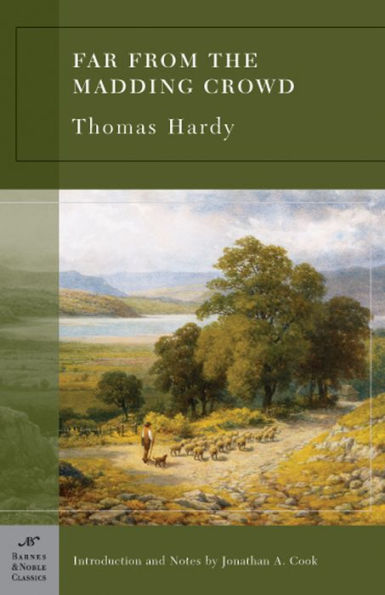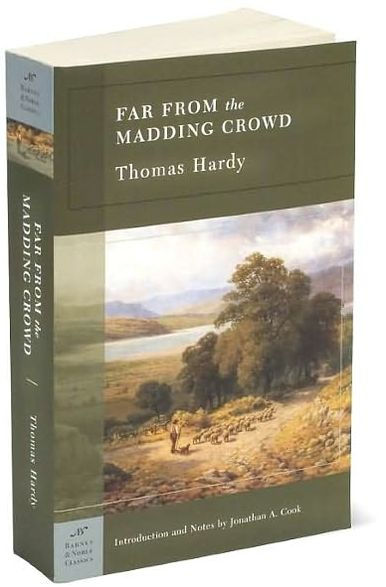Read an Excerpt
From Jonathan A. Cook’s Introduction to Far From the Madding Crowd
Hardy described his new novel to Leslie Stephen as “a pastoral tale,” and the very title of the novel announced its rural pedigree. The author derived his title from the nineteenth stanza of Thomas Gray’s well-known “Elegy Written in a Country Churchyard” (1751), a pastoral meditation on the undistinguished but not undignified lives of rural dwellers:
Far from the madding [that is, frenzied] crowd’s ignoble strife,
Their sober wishes never learn’d to stray;
Along the cool sequester’d vale of life
They kept the noiseless tenor of their way.
Hardy’s novel hardly presents characters whose “sober wishes never learned to stray”; indeed, misdirected and thwarted desires are the very stuff of the novel’s drama. But he nevertheless gives his rural characters the kind of dignity and humanity that Gray commemorates in his pastoral elegy and that Hardy was bestowing on a new fictional domain based on his native Dorset. The borrowed lines from Gray’s poem may be said to act as a generic marker for Far from the Madding Crowd in that many of the basic elements of plot, characterization, setting, and imagery in Hardy’s novel can be directly linked to the traditions of the literary pastoral. In Far from the Madding Crowd, as in the pastoral tradition generally, humanity lives largely in harmony with nature, and the year is marked by the natural rhythms of the seasons and the labors of agricultural life. In order fully to appreciate the novel as a manifestation of pastoral, it is necessary briefly to review the long literary tradition to which it belonged.
The pastoral tradition in European literature began with the Idylls of the third-century B.C. Greek writer Theocritus, whose poems often focused on the simple lives and loves of shepherds and goatherds, nostalgically recalled from the writer’s native Sicily. The rural subjects of Theocritus’ verse included musical and poetic contests, mythological narratives, seasonal celebrations, and elegiac laments. The tradition of classical pastoral poetry was further elaborated by the first-century B.C. Roman writer Virgil in his ten Eclogues, based on Theocritan models, as well as the Georgics, a four-part didactic poem on the required labors of the agricultural year regarding crops, trees, vines, livestock, and bees. Following Virgil, an implicit assumption of pastoral poetry was that rural life was morally superior to urban civilization. Pastoral literature was revived in the English Renaissance in the work of three of the era’s leading writers: Edmund Spenser’s Shepheardes Calendar (1579), a medley of twelve poems based on Virgil’s Eclogues and featuring song contests, elegies, laments of scorned lovers and frustrated poets, and criticisms of corruption in the late-sixteenth-century English church and state; Sir Philip Sidney’s Arcadia (1590), a long prose narrative, set in an imaginary Greek provincial realm, combining chivalric romance with traditional pastoral interludes, and structured around the principle of rustic retreat from the outside world; and William Shakespeare’s As You Like It (c.1600), a romantic comedy representing the sentimental benefits— and ironic deficiencies— of withdrawal to a sylvan retreat, the imaginary Forest of Arden, from the perilous environs of the court. Pastoral poetry continued to be written through the eighteenth century by Alexander Pope and others, but at the risk of becoming artificially restricted to the classically defined rules of the era. Although anticipated in some of the poetry of Gray, Oliver Goldsmith, and George Crabbe, it was only with William Wordsworth’s re-creation of the pastoral using realistic rural characters and simplified diction that the tradition was renewed and made available to Hardy’s influential precursor George Eliot in her novels Adam Bede (1859) and Silas Marner (1861), and then to Hardy himself, beginning with his second novel, Under the Greenwood Tree (1872), the title of which was based on a line from a song in As You Like It.
In essence, literary pastoral presents an idealized portrait of rural life, in the process offering a systematic preference for country over city life, simplicity over complexity, nature over artifice, and tradition over innovation. Explicitly named after the shepherds who formed its first subject matter, pastoral poetry often traced the romantic aspirations and disappointments of simple herders of sheep and goats, whose outdoor work allowed time for music, especially on the panpipes or flute, song contests, and debate on various sentimental, agricultural, political, and folkloric topics. The English pastoral novel of the nineteenth century blended some of the idealized themes and motifs of classical and Renaissance pastoral tradition with the more realistic contemporary conditions of the English rural community and natural landscape.
In writing Far from the Madding Crowd, Hardy combined many of the basic themes and motifs of classical pastoral tradition, but synthesized them with a realistic portrayal of contemporary rural English life. The novel’s grounding in pastoral tradition appears in the various farm laborers who perform a choral role in the narrative and exemplify the symbiotic existence of nature and humanity in the novel. It is also evident in the novel’s major characters: the faithful shepherd Gabriel Oak; his “mistress,” the beautiful but capricious farm owner Bathsheba Everdene; her love-sick older admirer, the gentleman farmer William Boldwood; and her selfish, predatory husband, Sergeant Troy, a disruptive antipastoral figure in the novel. In keeping with the seasonal structure underlying some examples of the literary pastoral, the action of the novel mirrors the seasons, as seen, for example, in Oak’s loss of his sheep in the winter, Boldwood’s preliminary courtship in the spring, Bathsheba’s involvement with Troy in the summer, and Fanny Robin’s death in the fall. Also indicative of the pastoral tradition in the novel are the descriptions of the phases of the agricultural year, including lambing, sheepshearing, hay-cutting, beekeeping, and harvesting, as well as of the rural institutions of market and fair.





